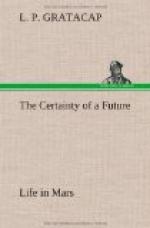“See the emanations of souls that dwell in the Sun descending upon the earth in the shape of solar rays. Light gives life to plants, and produces vegetable life, to which sensibility belongs. Plants having received from the Sun the germ of sensibility transmit it to animals, always with the help of the Sun’s heat. See the soul germs enfolded in animals develop, improve little by little, from one animal to another, and at last become incarnated in a human body. See, a little later, the superhuman succeed the man, launch himself into the vast plains of ether, and begin the long series of transmigrations that will gradually lead him to the highest round of the ladder of spiritual growth, where all material substance has been eliminated, and where the time has come for the soul thus exalted, and with essence purified to the utmost, to enter the supreme home of bliss and intellectual and moral power; that is the Sun.
“Such would be the endless circle, the unbroken chain, that would bind together all the beings of Nature, and extend from the visible to the invisible world.”
From that moment, moved more and more by the strangeness of the fancy, which evidently fascinated him, he buried himself in the indulgence of the thought of the possibility of some sort of communication with his wife. Singularly and fortunately he did not have recourse to the fruitless idiocy of spiritualism, nor engage in that humiliating intercourse with illiterate humbugs who personate the minds of men and women almost too sacred to be even for an instant associated in thought with themselves.
In 1881 electrical science had well advanced toward those perfected triumphs which give distinction to this century. Electric lighting was well understood, the Jablochkoff and Jamin lamps were then in use, the incandescent and Maxim light, or arc light were employed, and indeed the panic caused by Edison’s premature announcement of the solution of the incandescent system of lighting had then preceded by two years, the excellent results of Mr. Swan in England in the same field. Edison’s first carbon light and his original phonograph were exhibited toward the end of 1880 in the Patent Museum at South Kensington.
The daily News of New York in April of 1881 published the victory of the Edison Electric Lighting Company over the Mayor’s veto in words that may be read to-day with considerable interest. It said “the company will proceed immediately to introduce its new electric lamps in the offices in the business portion of the city around Wall Street. It consists of a small bulbous glass globe, four inches long, and an inch and a half in diameter, with a carbon loop which becomes incandescent when the electric current passes through. Each lamp is of sixteen candle power with no perceptible variation in intensity. The light is turned on or off with a thumb screw. Wires have already been put into forty buildings.”
My father had anticipated the incandescent light in its fuller later development and had used, before it was announced by Prof. Avenarius of Austria, a method of dividing the electric current, by the insertion of a polariser in a secondary circuit connected with each lamp, a method, it need not be said to electricians, now utterly obsolete.




